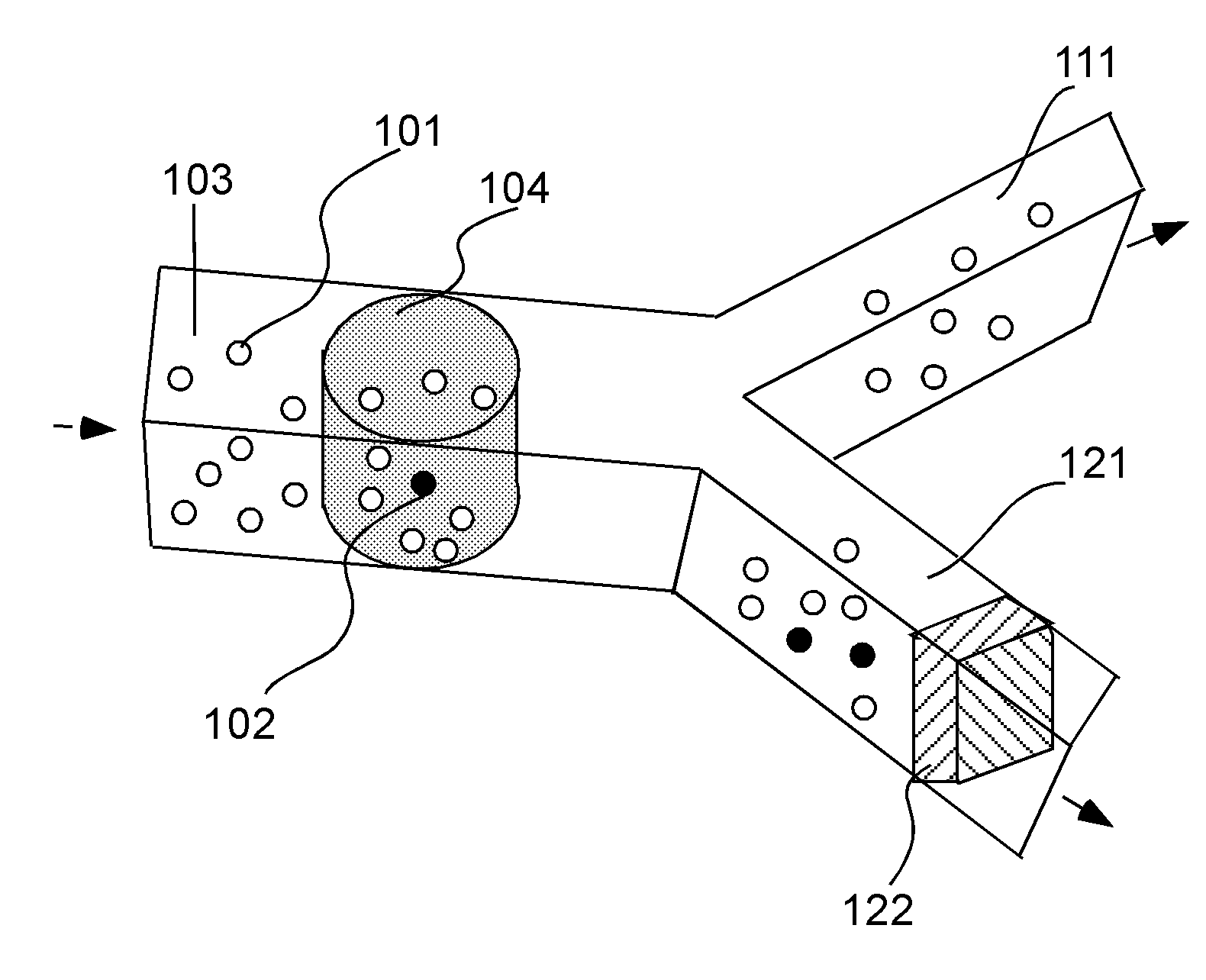Ensemble-decision aliquot ranking
a technology of aliquot and ranking, applied in the field of overalldecision aliquot ranking, can solve the problems of unsuitable for detecting or recovering rare cells, reducing the clinical value of aliquot, and wasting time in deciding the trajectory of every cell,
- Summary
- Abstract
- Description
- Claims
- Application Information
AI Technical Summary
Benefits of technology
Problems solved by technology
Method used
Image
Examples
example 2
[0240]B. Example 2
[0241]eDAR apparatus with two outlet ports for the detection or quantitation of rare particles in a fluid.
[0242]FIG. 5 illustrates an eDAR apparatus consisting of a device to aliquot cell suspension (510), an interrogation device (521), a detection or imaging device (531), a ranking device (computer not shown), and an apparatus to direct aliquot according to the assigned ranking This apparatus also includes a single inlet port (511), two outlet ports (512 and 513), and three fluidic channels (514) joined at a single point to aliquot the fluid. A laser serves as the interrogation device (521) and an inverted microscope with photodiodes, photomultipliers, or cameras serves as detection device (531). A mask (551) is placed between the channels (514) and the detection device (531). A computer accepts the signal from the detection device and ranks the aliquot through an algorithm. The device then utilizes an electrical, magnetic, hydrodynamic, or pneumatic mean to direc...
example 3
[0244]C. Example 3
[0245]eDAR apparatus with multiple inlet and / or outlet ports for the detection or quantitation of rare particles in a fluid.
[0246]In various aspects of the invention, an eDAR apparatus may consist of multiple inlet and / or outlet ports. For example, FIG. 7 illustrates a device (710) to aliquot suspension with five ports (711, 712, 713, 714, and 715) and five fluidic channels 716 joined at a single point. One or more ports may be used as fluidic inlet; one or more ports may be used as fluidic outlet. For example, the apparatus may be used such that two ports are used as inlet ports and three ports are used as outlet ports, or it may be used such that one port is an inlet port and four ports are outlet ports, etc. In theory, the device (710) may contain any number of fluidic inlets and outlets and any number of fluidic channels. These fluidic channels may be joined at more than one point and the joining point need not be circumscribed by the fluidic inlets or outlets....
example 4
[0247]D. Example 4
[0248]Detection of circulating tumor cells (CTCs) in the blood of breast cancer patients by the use of eDAR.
[0249]Freshly venipunctured blood from Stage IV metastatic breast cancer patients was drawn from a single puncture into three separate tubes. The first blood portion (first tube) was discarded to avoid possible contamination of epithelial cells from skin puncture. A second portion was collected into Veridex's CellSave tube containing stabilizing reagents for circulating tumor cell detection using a Veridex's CellSearch system. A third portion was collected into a collection tube containing EDTA anticoagulant for separate analysis using eDAR.
[0250]The third portion was incubated with enzymes, fixatives, permeability reagents, and fluorescent antibodies targeting pan-cytokeratin, CD45, and Epithelial Cell Adhesion Molecule (EpCAM). A positive identification of circulating tumor cell is defined as a cell expressing pan-cytokeratin and EpCAM, but not CD45. CD45 i...
PUM
| Property | Measurement | Unit |
|---|---|---|
| size | aaaaa | aaaaa |
| diameter | aaaaa | aaaaa |
| volume | aaaaa | aaaaa |
Abstract
Description
Claims
Application Information
 Login to View More
Login to View More - R&D
- Intellectual Property
- Life Sciences
- Materials
- Tech Scout
- Unparalleled Data Quality
- Higher Quality Content
- 60% Fewer Hallucinations
Browse by: Latest US Patents, China's latest patents, Technical Efficacy Thesaurus, Application Domain, Technology Topic, Popular Technical Reports.
© 2025 PatSnap. All rights reserved.Legal|Privacy policy|Modern Slavery Act Transparency Statement|Sitemap|About US| Contact US: help@patsnap.com



